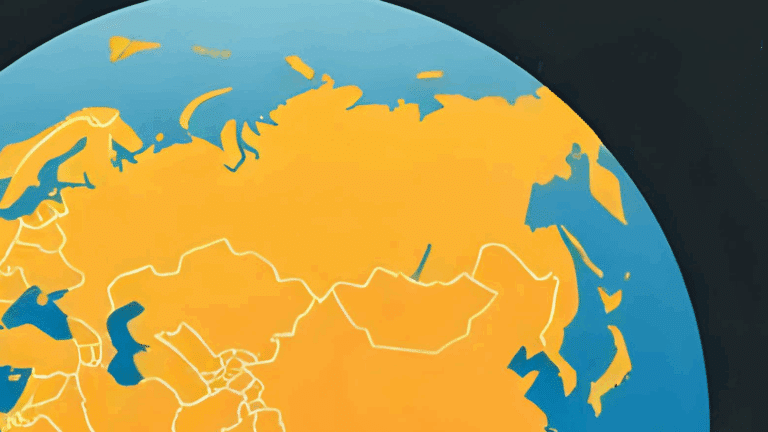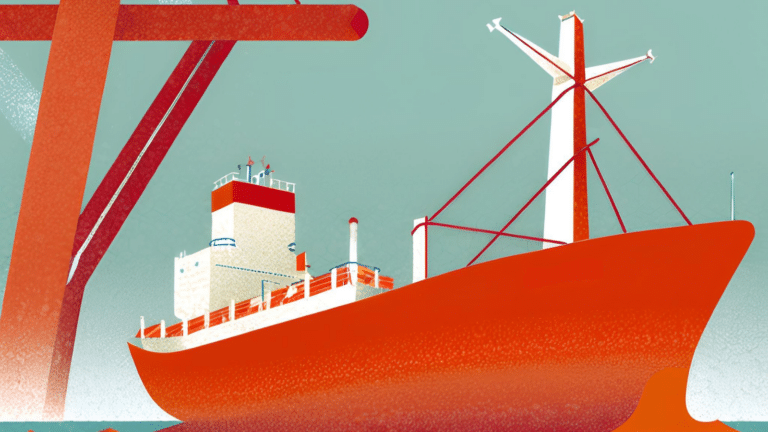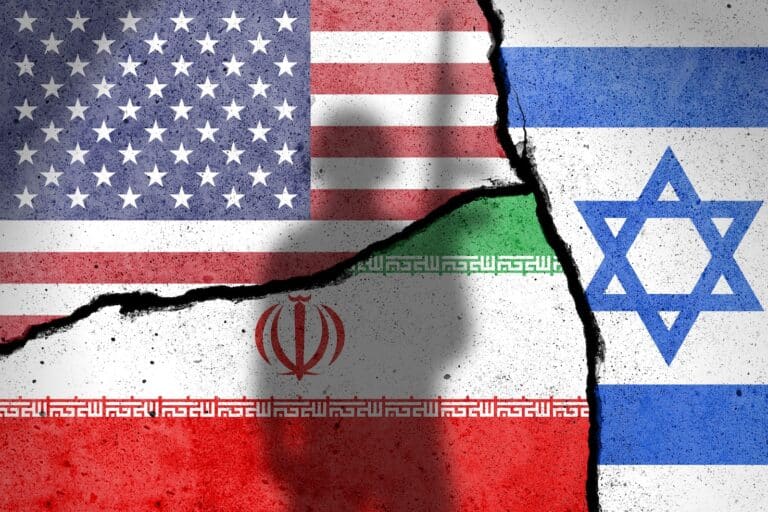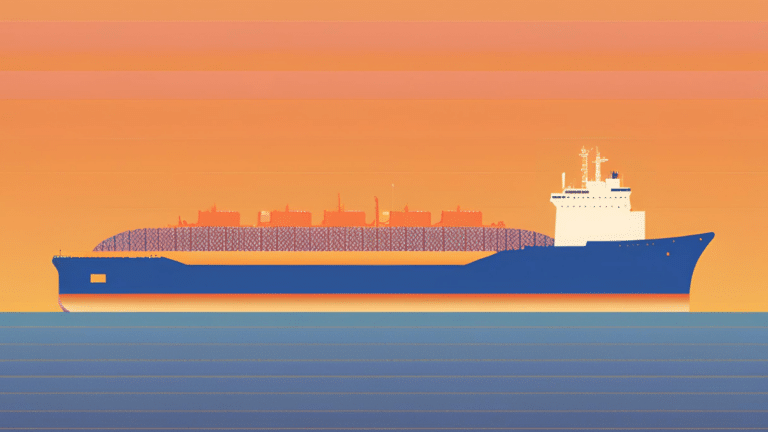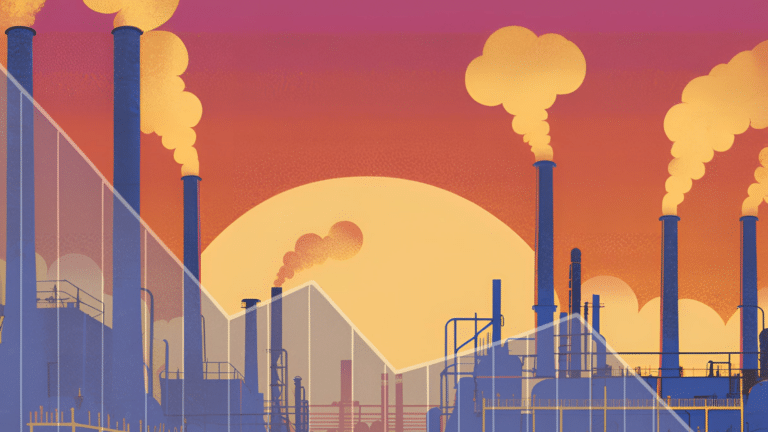Anne-Sophie Corbeau:
Over the past two years, we got really lucky, especially with the weather in 2022. Most of the demand destruction didn’t come from the policies, but from the mild weather and industrial gas demand destruction, these were the two main components accounting for roughly 60% of the gas demand reduction in 2022. So the policy achievement was that we got lucky with the weather, which is not a policy achievement at all.
Jason Bordoff:
Europe is facing a challenging year as natural gas prices there surge. While the continent seemed to successfully navigate the initial shock of losing Russian gas supplies, it’s now clear that many were declaring victory too soon. Storage levels are dropping this winter and the loss of Russian pipeline gas through Ukraine has left Europe even more dependent on global LNG markets. Meanwhile, in the United States, president Trump’s administration has promised to unleash American energy dominance in part by lifting restrictions on new permits for LNG exports. But questions remain about domestic gas production capacity, infrastructure constraints, and the potential impact on US gas prices. How are these developments reshaping global gas markets and what do they mean for Europe’s industrial competitiveness? How might geopolitical tensions affect the future of global gas trade and what does all of this mean for the priority of reducing greenhouse gas emissions?
(01:32):
This is Columbia Energy Exchange, a weekly podcast from the Center on Global Energy Policy at Columbia University. I’m Jason Bordoff.
Today on the show, two of our own Anne-Sophie Corbeau and Ira Joseph and Sophie is a global research scholar here at the Center on Global Energy Policy where she focuses on hydrogen and natural gas. Her career in the energy industry spans over 20 years, including stints as the head of gas analysis at BP, Senior Gas Analyst at the International Energy Agency and Research Fellow at KAPSARC in Saudi Arabia. Ira is a senior research associate at the Center on Global Energy Policy. Previously he headed global generating fuels and electric power pricing at S&P Global Platts. Before that, he was the global head of gas and power analytics at Plats. Anne-Sophie and Ira joined me to discuss Europe’s current energy challenges, the impact of US energy policy shifts and the future of global gas markets. We explored the complexities of industrial competitiveness, the role of Russian gas and the environmental implications of expanding LNG trade. We also discussed the role of AI data centers as a potential game changer for gas demand and what recent geopolitical tensions mean for international gas trade. I hope you enjoy the conversation.
Anne-Sophie Corbeau, Ira Joseph, welcome again to Columbia Energy Exchange. Great to see you both.
Ira Joseph:
Great to see you too Jason.
Jason Bordoff:
This is one of the most fun parts of the job. I get to talk to such interesting people on this podcast, but it’s always the most fun to talk to the brilliant colleagues that I have here at the Center on Global Energy Policy and learn from them when times are interesting, which they are definitely interesting right now. And you guys are two of the leading experts, voices of insight on lots of issues, but including how to think about what’s happening in global gas markets, markets for low-carbon fuels like hydrogen, what’s happening with energy security, particularly in places like Europe. And I want to talk about all of those things, but maybe I could start with you Anne-Sophie and just set the scene for people listening. Why are we talking about this? I remember about a year or so after Russia cut off most gas supply to Europe, relatively mild winter and Europe made it through no problem. And a lot of people seem to be taking a victory lap that we had figured out how to address our energy needs without Russian supply, but it’s both in Europe and in the United States and elsewhere. I see lots of headlines these days about natural gas, about energy prices and about LNG. Why is that? What should we be talking about today?
Anne-Sophie Corbeau:
Well, simply because in Europe, TTF prices have reached record level again, they are at 55 euro per megawatt hour, which is twice as much as we were exactly one year ago. So one year ago, I think a lot of politicians in Europe were declaring victory, the crisis over. Now we can finally get rid of Russian gas, either pipeline gas or LNG. But actually what we have not seen is the fact that on the global gas market there was relatively little LNG coming to the market. And in fact in 2024 we had only two small projects coming online, one in Congo and one in Mexico. And the big project which was expected to come online in Russia, Arctic LNG 2, actually, well it came online but was hammered by US sanctions. So basically it didn’t go anywhere. As a result of that, there was relatively little L energy supply coming to the market in 2024.
But we were lucky in Europe because we had a mild winter, winter of 2023/24. So the storage at the end of that winter was relatively high. However, this year, because guess what, we have a normal winter. I mean it’s not even cold, cold, it’s just normal. And also in November December, 2024, we had an episode of dunkelflauter, which is when you have relatively cold weather but also very low wind. We had a surge of gas demand in the power sector. So the situation is that the storage is not record low but is in line with the five-year average. However, it’s in line with the five-year average with only 15 billion cubic meters of Russian pipeline gas left. We have lost in January, 2025, 15 BCM of gas transiting for Ukraine. So that makes the whole supply situation in Europe much more difficult than before because now the only thing that Europe can do is basically go to the global gas market, go to the global LNG market and try to secure LNG. And that is problematic because yes, there will be a little bit more LNG coming to the market in 2025, but Europe will be in competition with Asia. That’s why the gas prices are so high today and Europe politicians are in full panic mode.
Jason Bordoff: Ira, what would you add to that?
Ira Joseph:
I think though, one thing I would add to that is I think that we’re at $16.50 per million BTU TTF prices. Another key reason for that I think is that a lot of the trading community is sort of front running the market because the EU has put a mandate in place that 90% of storage has to be full by November 1st. And as Anne-Sophie said, we’re below 50% now, but the amount of storage that’s going to need to be injected between April and October is going to be on the high side if not a record amount of gas that’s going to be needed to be injected in storage just to get to 90% of this capacity. So I think that is just like a screaming bullish sign, I think, for the market that nobody wants to be anything but long in this market because they know there are buyers out there that must buy gas over the next well over that six month period, but it’ll be a seven month period. So I think that’s really important and the key thing to look at from a policy perspective to see if the EU sort of lightens up or changes this mandate for certain countries going forward.
Jason Bordoff:
Anne-Sophie, help people understand the causes of this much higher set of energy prices this winter. Is it just about colder weather or are there other things going on?
Anne-Sophie Corbeau:
So this is a mixture. This is colder weather, actually not it’s colder than the previous years. It’s not cold in absolute terms. It is a normal winter. So there is that. There is a fact that we had lower wind generation which has increased against the demand in the power sector and the fact that we have also lost 15 billion cubic meters of Russian pipeline gas going through Ukraine. So you combine everything plus the fact that the storage at lower levels than the previous years, even though this is normal levels from an historical perspective means that we need to refill a lot more as Ira mentioned, than anticipated. And this is creating this crazy situation where the summer prices are higher than the winter prices and therefore if you are a market player and you want to put gas in storage, there is absolutely zero incentive to do so right now because you know you are going to be losing money.
Jason Bordoff:
And does that use the word normal a lot. And so I guess the question I have for you is whether actually last winter people got lucky and what’s happening this winter is the new normal that year after year we’re going to see much higher price – the consequence of what happened with Russia invading Ukraine, Russia cutting off gas supply Europe saying we’re not going back to Russian gas, we’ll come back to the question of whether that’s going to last or not. And we should remember somewhere around a third, maybe a little less, of European gas consumption I think still comes from Russia in the form of pipeline and LNG. So it’s not zero, but it’s much less than today. But the idea that the consequence of that is this is a new normal of pretty high energy prices driven by natural gas prices, renewables still growing, et cetera. But obviously gas is still critical and this is a huge issue for Europe if I’m right, in terms of economic competitiveness, industrial competitiveness, the report on competitiveness by Mario Draghi, it’s not really a bright outlook. How does that change moving forward or can it?
Anne-Sophie Corbeau:
Over the past two years we got really lucky, especially with the weather. In 2022, most of the demand destruction didn’t come from the policies but from the mild weather and industrial gas demand destruction, these were the two main components accounting for roughly 60% of the gas demand reduction in 2022. So the policy achievement was that we got lucky with the weather, which is not a policy achievement at all. Now going forward we know that we are going to have a lot less Russian gas and there is only 15 billion cubic meters of Russian pipeline gas left. A lot of policy makers in Europe are now also focusing on Russian energy, which is still coming to Europe. There is about 20 billion cubic meters of Russian energy which came to Europe in 2024. A lot of European policy makers are very unhappy about that. So they are trying to think about how we are going to get rid of Russian LNG.
I would argue maybe this is not the right time, just wait until there is a lot more LNG on the market to deal with that. You are mentioning European competitiveness and indeed the industrial sector, the industrial sector has been literally hammered because of the very high gas prices and also higher gas prices compared to a lot of other countries in particular the United States, but also countries in the Middle East, et cetera. So the competitiveness is a big issue. We have lost about 20% of our industrial gas demand. There was a teeny bit of a recovery in 2024 because as I mentioned, the gas prices were actually quite low at the beginning of 2024. But now when we are looking at the current gas prices, it’s pretty much obvious that gas demand in the industrial sector, it’s probably going to decline again. I have been talking to many industrial players, not only are they in full panic, but they’re actually saying, or they were saying at the end of 2024, actually we would really like Russian pipeline gas transit for Ukraine to remain because we know that it’ll have a downward impact on gas prices. So this is what they’re thinking and I know especially in Germany, they are in absolute utter panic.
Ira Joseph:
I just wanted to add a couple of things if it’s okay, Jason, to what Anne-Sophie said is that this is not something that has also just happened over the last year or two. European gas demand in 2010 was 650 BCM for the year. Now in 2024 it’s down to 450 BCM, that’s 30% less gas. But at the same time, the amount of storage capacity in Europe has actually grown from, let’s say, 55 BCM to 110 BCM of capacity. So investments were made. But the key point about that is this storage is not just for Europe, it’s for the whole world. And this is kind of the way we can’t just look at Europe in a vacuum anymore. It’s this entity that now exists as part of the global gas market and the gas that’s going to be stored in Europe or that could potentially be stored in Europe this summer isn’t just for Europe. It’s also in a de facto way for Asia as well because as we’re going to talk about here in a little while, the situation is about to change pretty quickly. The amount of LNG supply that’s coming into the world is going to increase by 50% over the next let’s say four years. And that’s a big, big uplift in supply, which is a very, very different story now. But if we’re sort of at the tightest of the tight mark, I would say we’re probably now or probably somewhere in the second half of this year.
Anne-Sophie Corbeau:
But maybe this LNG is going to come too late. I mean I would say that 2025 is a year of life and death for Europe and especially for the industrial sector because we have these gas prices which are very high. We have the electricity prices which are also very high because we stopped the reform which was aiming at decoupling electricity prices from gas prices. And on top of that we have all these geopolitical elements like Mr. Trump who is now the president of the United States. And he said before that he want to relocate European industrial sector to the US because they have cheap gas and he may very well do so. There is also competitiveness from China. So I would argue that this year is crucial for Europe. If we don’t make it then this is going to be over.
Jason Bordoff:
This is going to be over. Just let’s be clear what you’re talking about. I mean when you say life and death, there are countries like Moldova and there are places where, or Ukraine…are you talking about industrial competitiveness when you use that kind of language?
Anne-Sophie Corbeau:
I am talking about industrial sector indeed and this industrial sector which has been talked about by many policy makers. But usually the kind of things that we are proposing are by far not enough. I mean in Europe we are obsessed with the regulation and all these things, but you need to really completely undo all these things. And I have to say that when I am looking at the proposal, sometimes I’m wondering whether we are on a different planet. I mean when I am at, let’s talk about hydrogen for example. In Europe it takes forever to get any funding even though there is a lot of funding available in the U.S., the inflation reduction act, which may be gone in a few months, but for the moment it was proposing a production tax credit. This is simple. This is very simple. So this is just one example.
Jason Bordoff:
Yeah, what I hear you saying, you wrote a paper, I forget when, shortly after the energy crisis really broke out in Europe and arguing that for all the talk of conservation and efficiency, what was actually happening was high prices doing what high prices do, which is destroy demand. And the industrial sector was bearing the brunt of this. And you argued why a lot of that was probably permanent destruction. This was not coming back to Europe. And what I hear you saying maybe is like this is the year we’re going to learn if that’s true and if things don’t change your pessimistic outlook for European industry is going to bear out.
Anne-Sophie Corbeau:
Yeah, that’s correct. Well we French tend to be relatively pessimistic, but I have to say that right now when I am looking at the gas prices, it’s very difficult to be optimistic
Jason Bordoff:
And we have a president, as you said, a new president here who is promising to solve these problems to unleash dominance and lift the ban on new export permits. And why doesn’t that take care of the problem Ira, I’ll start with you.
Ira Joseph:
Well, it’ll take care of the problem if somebody is willing to sign up to buy the LNG. And right now we’re not seeing a lot of that out there. I mean there are a lot of U.S. LNG projects struggling to sign long-term contracts and if you can’t sign a long-term contract in a majority of the cases you can’t have your project financed and therefore you can’t get the project built. So while there is a need for more LNG, a lot of the LNG that is needed has already been paid for or financed and it’s coming to the market. The question is after this 50% bump up in LNG capacity that we’re going to have over the next four or five years, what comes after that? And whether there’s a market for that because as Anne-Sophie said and is right, if you’re having industrial gas demand destruction $16 in Europe, it’s the same price more or less in Asia as well.
So if you have to import gas or specifically if you have to import LNG, how can you sustain an industrial gas base without it being subsidized in some way by the government? We certainly see this happening in India but also among the key smaller buyers of LNG, which, when you look at 2024, we really started some of the key areas for higher prices. When you look at the Pakistans and the Indonesias and the Philippines of the world, that’s where the incremental growth is really coming from. Apart from China obviously, which was a very, very large growth market. This is where it needs to happen. And so when you look at pricing realistically, can you expect strong LNG demand growth for any kind of LNG price above $10 per million BTU? And I would have to argue no. And certainly the buyers are resisting these type of numbers that are being asked of them. And so we’re going to have a very different looking LNG market in the upcoming years when all this new supply comes into the market and a lot of it has to be traded out and we’ll see what happens with prices over that time.
Jason Bordoff:
I mean you’re describing a market I think where there might be oversupply, but oversupply I assume will have the effect of prices coming down. So what is your outlook for gas demand then at maybe the prices you’re talking about? Maybe people are turning to renewables or coal instead, but if there’s that much supply coming online, then isn’t it the case that the outlook almost sort of has to be bright for gas demand because a lot of supply will just lead to low prices and at the right price people will find a way to use it?
Ira Joseph:
That’s right. So as I said, the gas is coming in the market one way or another. So one of two things is going to happen. The gas is going to be priced down to a level where it can displace other things in other markets that are being consumed for energy, whether that’s coal or renewables or even oil or the gas is going to be shut in and is not going to enter the market. And there’s certainly two potential areas for that. I mean the Qataris are bringing in probably a third, I think that’s about the number, no, maybe a quarter let’s say of the additional LNG coming into the market, whether they’re willing to restrain their production in some way like they did before Covid when the last time we had sort of a temporary oversupply situation. And then of course the U.S. producers are going to be the other swing area because the U.S. destination flexibility, U.S. pricing and the relationship between Henry Hub and other spot markets around the world is going to become a lot closer in the years ahead and the market is going to swing based on U.S. LNG exports
Jason Bordoff:
Anne-Sophie, can you talk about how you see what you’re seeing coming out of the new administration in Washington and what do you think that means for the issues we’re talking about?
Anne-Sophie Corbeau:
Well I don’t think the administration is going to do that much immediately for the market. I mean the LNG plans are under construction. So what Mr. Trump is trying to do is really about new LNG plans which are going to come online much later in a few years from now. So for Europe, this is totally irrelevant. I would say that right now we are indeed looking at a lot of LNG coming online. If I’m looking at everything which is under construction including the mothballed plant in Russia, this is about 320 billion cubic meter. But how big a number is that in context? It’s a huge number. Global LNG trade in 2024 was about 560 billion cubic meter. So this is absolutely gigantic. However, there is a project in Russia which for the moment is dead in the water. There is a project in Mozambique which is not doing particularly well ever.
So we are left with a lot of US LNG projects and the price at which this LNG is going to run to the market is also going to be determined by the price of US domestic gas. I think we will come back on that and there is also a bit of uncertainty on what the categories are going to do because they are coming with about 80 billion cubic meters of additional gas. I was looking at all the projects and what I was noticing is that quite a few have actually been delayed to a later stage. So instead of having an immediate bump in terms of additional supply, which at the beginning we were really expecting to see starting in 2025, everything has been pushed back to 2026 and really 2027 is in principle the year where the cavalry arrives. But will the cavalry arrive in time to save Europe? That is a big question.
Jason Bordoff:
Trump has said he will unleash energy dominance, lift the ban on permits for as you said, new plants. I mean the existing plants were already coming even though we have a new year-long study that came out of the Department of Energy just before the Biden administration ended, which according to the summary provided by outgoing Secretary of Energy Granholm shows why exports are bad for the US economy and bad for the environment. Maybe you, Anne-Sophie, could talk about that and Ira you could as well.
Anne-Sophie Corbeau:
Honestly in a nutshell, this whole report is a disgrace. As an analyst I’m going to say that very bluntly. Let me give you five reasons. The first one is when you are publishing something at the end of 2024, you are kind of making sure that the numbers for 2025 do not look completely rubbish. They do. I mean whether you are looking at US LG export, global gas demand, gas demand in the US power generation sector, they are looking completely bizarre. Second point is when you know that you are going to have a massive expansion of US LNG export and you are looking at the picture number one in the executive summary and this is showing almost a flatline or slightly increasing between 2025, 2030, I mean seriously do you know that there are a lot of projects which are currently under construction in the United States? So it looks very implausible that they are not going to increase massively the US LN energy export.
Third problem, which is the biggest one for me, are the numbers on global LNG trade. I mean they are beyond implausible. I don’t know what the model is running on, I mean cocaine, hashish, you tell me, but this is completely crazy. The highest number in terms of global LNG trade is beyond 2000 billion cubic meters. I mean the highest number that we have like BP, Shell, et cetera, are in the range of 1000 billion cubic meters. This is as if you were telling me, oh yeah, let’s have global oil demand as 200 million barrels per day. This is as bizarre and you know how they get to that number. Well Russia is importing LNG and quite a bit of LNG. Central Asia is importing LNG. I mean just look at the map. Can you explain to me exactly how central Asia is getting LNG? I mean is Mr. Musk going to retrofit the LNG takers on top of a spaceship? I don’t know. I mean this is completely stupid. Norway is stopping almost immediately it’s exports by pipeline, is replacing that by LNG. I mean there are so many crazy things in this report about the global LNG balance that for me it’s bizarre. Totally bizarre.
Jason Bordoff:
And just so I understand that point before you go to the next one, the kind of headlines coming out of it or frankly what was in Secretary Granholm’s summary of an impact of roughly a dollar in 2050, which one could argue is actually pretty small, but even that impact is that the scenario you were just talking about where you need to make kind of those extreme assumptions about how much gas the world is using?
Anne-Sophie Corbeau:
So this was a report which has a slightly lower number in terms of global LNG export but still 1600 billion cubic meters is a lot. As I said, the highest number that we usually have are in the range of 1000 billion cubic meters and they are as implausible in terms of Russia importing LNG, central Asia importing LNG. So this scenario doesn’t make any sense to me. I am sorry but I don’t know what they did with that scenario. Also in terms of the impact in terms of gas prices, I was surprised by two things which is that it says in the executive summary, the study doesn’t include forward looking modeling on the impacts of increasing LNG exports to consumer price volatility. Hey, I thought that should be quite an important topic of the study, right? And also we have spent 2024 saying, oh my god, AI is going to increase power demand so much and what do we have in pretty much all the scenarios gas demand, is the power sector declining?
I mean so you see guys, do you get out from time to time? Are you listening to what people are saying? I mean why don’t you have at least in one or two scenarios gas demand in the power generation increasing? And finally I was actually really, really, really looking forward to the study, really. I mean one of the elements which actually triggered this whole pose and this whole study was a methane emission and the assumption that actually US energy is worse than coal. Methane is quoted seven times in the executive summary. The whole analysis is buried somewhere in appendix C is actually very, very short. So I would argue that they have not done their job in terms of looking at the methane emissions, which in my opinion is absolutely crucial because you want to make sure that the next generation of LNG export plants are fit for the future, especially considering the new regulations in Europe on methane emissions. So they have not done their job. So for me the fate of this study should be the rubbish bin. If you have already printed it then I can suggest origami for your kids
Jason Bordoff:
Ira, Ann’So is being typically reticent and reluctant to express herself. Anything you want to add to that?
Ira Joseph:
Yeah, I’ll leave the final word on that to Anne-Sophie, and I’ll just add a couple of things. I think sort of with the promotion of LNG by the new Trump administration, I mean as we alluded to before, and Anne-Sophie and I we like to focus on this a lot. Qatar still has 60 million tons of LNG completely unsold of this new capacity that they’re going to build. So the idea that even more LNG is going to be green lit and even more LNG is going to be financed even if the administration puts its thumb on the scale for LNG exports, it seems pretty unlikely unless we were to see some type of government to government deal. But that being said, the Alaska LNG project, which has been around for five decades in different iterations in its most recent over the last 10 years is getting all kinds of press right now because the Japanese government has always been interested in that project and the US government or at least the state of Alaska has always been interested in making that project go forward as well.
So that arguably of all the US LNG projects out there is probably the least commercial and would need the most amount of government assistance is even getting love from the new administration. So I think at least I’m going to have to look at this a little differently than I did before. And another thing to add in the golden age of gas, which has basically been the last 20 years, I just did a new paper that’s going to come out on CGEP in the next couple of weeks that showed that even in the golden age of gas, a vast majority of the gas demand growth was coming from the countries where the gas was produced and that the idea that the gas growth was coming from trade and from LNG, it was sort of more in a back burner. Now with this increase in capacity coming forward with the 50% increase in capacity, we’re going to have to see if this golden age will continue or how this golden age is going to evolve with all this new supply coming to the market because it’s going to look very different than it did before, particularly in the US.
And that leads to this issue, Jason, that you were referring to or alluding to about can we expect price increases in the US if we have more exports, if the US is going to be exporting 25% of its gas production, if you include LNG plus pipeline exports to Mexico, will that have an on Henry hub prices? I would say unquestionably it’s going to have an effect on Henry Hub prices both to the high side and to the low side because Henry Hub is going to adjust to the global market and the global market is going to at times have to adjust to Henry Hub. So I think the integration of the market certainly is coming and the market will be traded in a very, very different way than before because over 50% of the market is probably going to be traded on a spot basis, whereas we’ve never seen anything close to that number in the past and that doesn’t mean it’s going to grow less or going to grow more, it’s just it’s going to be a lot different than it was before. In much the same way the crude oil market evolved post late eighties into the nineties into what it is today.
Jason Bordoff:
I’ll just say if any authors of the report are listening, don’t take it personally. Ann’So is brilliant and blunt and direct and Ira and myself have been on the receiving end of that as we critique one another’s work internally and it makes the work better.
Anne-Sophie Corbeau:
I was disappointed in the report, let’s put it that way.
Jason Bordoff:
I couldn’t tell you were kind of beating around the bush and just…
Ira Joseph:
Yeah, come on, tell us what you really feel.
Jason Bordoff (30:48):
So can you comment on what Ira just said? He said something I think is maybe really important. We’ve been able to become the largest LNG exporter and have some of the cheapest gas prices in the world. The gas market has not worked the way the oil market does where there’s roughly speaking with some small differences, a global price, it’s cheap here and you get a big price for it somewhere else in the world. But we’re going to this different world with a lot roughly doubling LNG export capacity. That’s a lot of demand. There’s some demand maybe for power generation for AI data centers on top of that, what impact does all of this have on domestic prices? Because you could imagine particularly for an administration that is lowering domestic prices front and center, the idea that we’re going to take US energy and send it halfway around the world and pay a price for it here at home, that’s might become an interesting political and economic issue.
Anne-Sophie Corbeau:
Well first of all, I mean assuming that we are taking about $3 per MBTU as a benchmark, I don’t see how you can really lower the domestic gas price. I mean we have seen that in the past, but what happened when you have $2 per MBT is that suddenly you have some domestic players who are saying, whoa, whoa, whoa, whoa, whoa, I am no longer competitive, therefore I am reducing my gas production. Also, maybe we need to take it to account what is potentially going to happen to oil prices. I don’t know. But suppose oil prices are diminishing for one reason or another that could also have an impact on associated gas production and the economics of associated gas production that way I’m not making any oil price forecast, but we need to take that into account. What I’m also concerned about in the short term is given we have a very fast increase in terms of LNG export and we have still relatively robust natural gas demand in the US whether production is going to increase fast enough in order to meet that and if next winter in particular we have very good winter, which is not impossible in the United States, then it could be a possibility to have price spikes.
And I am not sure that the new administration, especially with the MAGA rhetoric, is going to be very happy about that with a potential consequence that they are going to say, whoa, why are we exporting so much gas? Actually we need to cut that. Are they going to card energy export or are they going to cut the pipeline gas exports to Mexico?
Ira Joseph:
Yeah, the facts I would say are that the US has to produce another 20 to 25 BCF a day of gas by the end of this decade. That has to happen no matter what. And even the amount of, and
Jason Bordoff:
Just again roughly for context for listeners roughly a hundred BCF a day market just so people
Ira Joseph:
That’s right in the current a hundred BCF a day of production. Sorry, thank you for adding that. Now as it stands, I would say only about half of that has pipeline capacity to take from the basins where the is being to produce where the gas is going to supposedly be consumed. And this is just within the next five years. As far as I’m concerned, if you’re looking at this market or you’re looking at gas, all eyes have to be on whether us upstream is going to be able to deliver the goods on this. As Anne-Sophie rightly pointed out, if you’re a bear on oil in particular, this becomes particularly difficult because right now associated gases accounting for most of the growth and when you have associated gas, essentially the price at the wellhead for the gas is zero or is a negative price and makes all of this work.
If you’re in a low price oil environment where you have to turn to Haynesville and other dry gas basins to produce the incremental gas, you’re talking about a substantial uplift in costs first of all, which of course will eventually lead to a substantial uplift in prices as well. And so while we have in a market $3.20 Henry Hub right now and $16, $17 gas in the rest of the world, this market is eventually going to converge to a $2- $3 range over time. Now whether that range is $3 to $6, %5 to $8 or $9 to $12 is certainly debatable and something we’re going to have to look at over time. But the market is going to converge to this range and it’s going to be converged to a range that are based on transportation, economics and differentials.
Jason Bordoff:
Just to make sure I understand what you’re both saying because this so much better, we have a lot of cheap gas in this country and what I heard Anne-Sophie say is yeah, but it is a question of timing and there’s periods of time, there’s spikes, there’s bottlenecks, and eventually yes, but we might see that in the near to medium term some of those pain points develop. But the question is in the longer term is it not just that let’s assume for the moment there’s a lot of cheap gas and Ira, you just talked about why some of it might be higher cost to bring to market if it’s dry gas not associated or something and you’re go into different basins. But in addition to that, it starts to become the case that the price somewhere else in the world is setting the price here in minus transportation differentials in the way you see for oil markets, which I think hasn’t really been the case to date. So it’s not just is it an extra 10 BCF a day of demand, 15 BCF a day of demand, whatever that increase in demand would do to price, whether it was coming from exports or power generation or something else. It’s a different dynamic where the gas market globally starts to work more like the oil market. That’s a different kind of mechanism that could have a bigger impact on US prices regardless of what the shape of the domestic supply curve looks like. Am I understanding this correctly?
Anne-Sophie Corbeau:
I mean for example, what we saw in 2020 was the fact that the global gas market was in such an over supply situation that it had an impact on US LNG export and also on the price of natural gas in the United States. So that can have, indeed, an impact and that’s why also I think that the DOE report actually missed a good opportunity to look at the impact of the global gas market on the US gas market as we should have done because this is becoming so important, this relationship.
Jason Bordoff:
Now, if you want to buy a combined cycle gas turbine from GE Venova, I think they’re close to sold out because everyone sees the need for 24-7, 99.999% reliable power for AI and data centers primarily. What’s your sense of these projections for domestic power demand, what role gas plays in that? Is this sort of all over hyped or is that going to be a major factor? Ira, you start,
Ira Joseph:
I’ll start. I mean certainly the forecast I’ve seen that range between three and 10 billion cubic feet a day of incremental demand just tied to data centers and AI tell two different stories. It started out as a stranded gas story where AI and data centers could pick up cheap gas in Marcellus and it would be a great way to use gas that was otherwise having trouble getting out of the basin. Then it became this ultra bullish story where no matter what the price is, we’re going to need more data center and AI demand and we’re going to be actually constrained to fulfill both the needs of domestic demand and export based demand as well. Hard to tell obviously when you look at now with the DeepSeek issues coming along and how real that is, this is sort of like it ranges between this is all like is going to be an overbuild like the fiber optic network was a couple of years back or something that this is very real and is more closer to the 10 BCF a day of incremental demand.
But the other thing I would point out, and this is another paper we’ve done for CGEP on the globalization of power and how power demand is becoming very dynamic around the world as well. And while Jason you correctly point out that you need 24-7 certainty to run your data centers and to run your AI in the US, what’s also true is the power load for these concepts and for these ideas can be shifted around the world on a dynamic basis if necessary. So it is going to be possible for data center demand and AI demand also to chase the cheapest kilowatt hour price around the world as well to some extent as well. So I think the power market also has to be looked at in a more global way and this becomes significant because most of the world’s power market or power markets I should say are heavily regulated and largely subsidized as well. So there’s a lot of cheap power around the world where data-centered demand and AI can go to chase it and it just doesn’t have to be in northeastern, northwestern Pennsylvania or some other stranded gas basin in the US.
Jason Bordoff:
Ann’So your thoughts on that?
Anne-Sophie Corbeau:
I mean as a gas person I have been really thinking that I was going for a rollercoaster because at the beginning of last year people were starting to talk about AI and big increase in power demand in the United States while in fact it had been flat since the crisis of 2008. So for me I was like okay, what is the implication for gas demand? And also with the Trump administration coming, it was put your views that well wind and solar which are not even quoted in the national energy emergency at the bottom of the page are not really going to be very popular. So that means an even more bullish outlook for natural gas and in the power sector but with DeepSeek at the impression of being at the bottom of this rollercoaster and thinking, okay, so what does that mean now for the demand for natural gas in the power sector? I still don’t know and that’s my problem. However, if all these companies which are building data centers want to have cleaner electricity, then there might be, also, a case for having CCUS added to those gas fire plants.
Jason Bordoff:
Can we talk about all of this in the context of an administration that is using or threatening to use tools of trade in energy like tariffs in maybe ways we haven’t seen before – obviously Canada and Mexico were the two most recent on the receiving end of those tariff threats. And then China is saying they’re going to retaliate by restricting US gas into the Chinese market. What does all of that mean? How do the tensions, maybe we can start with North America, you wrote a piece Ira on Mexico’s growing reliance on US gas, how vulnerable are they? Maybe Anne-Sophie you could talk about that and also US Canada trade.
Ira Joseph:
Well, I mean when you start with Mexico you’re talking about a nine to nine and a half BCF a day gas market that’s importing six to seven BCF aday from the us. So if that’s not reliance, I don’t know what is. So you’re plus including an export an LNG export facility that New Fortress just built, which is importing gas to export it and a couple of other LNG projects like Mexico Pipeline Limited that wants to import US gas to export gas in terms of LNG from the Mexico west coast. So the reliance is pretty clear. At the same time the US is still importing around six to seven BCF a day of gas from Canada every day. So it’s kind of a net, pun intended, net zero situation between the two countries and LNG Canada is going to start up this year and that’s going to pull another two to three BCF a day of gas towards the Canadian west coast.
So I think with the tariffs, I’m not too particularly worried about it changing anything in a monumental way on the Canadian side, but as Diego Garcia and I wrote in the paper, I’m very worried about the US Mexican gas trade getting muddled in with all of the other issues that have popped up with Mexico with immigration, the drug trade and just general levels of politics, the US Mexico gas trade has been able to step aside and hide from these issues and not really be affected. But with this administration clearly looking at business and mixing it with politics the way they do it seems inevitable to me that that gas trade is going to be affected by the administration at some point.
Anne-Sophie Corbeau:
I’m going to talk more about China because I think our piece on the impact of the tariffs that China has just put on us LG, they’re not forbidding us LNG to come to China. They have just put on tariff as they did a few years ago. And actually the tariff are much lower than what we had in 2018 and 19. I mean in 2019 they were to 25%. Now they’re only 15%. I think China is signaling that they want to retaliate but in a relatively measured way, they’re open to dialogue. I think they were open to a discussion, but at the same time what is very interesting is that even with the 15% tariff, I mean this is still making US LNG competitive compared to the spot price of gas. So I am not quite sure that the Chinese LNG importers are going to stop importing US LNG.
They might actually ask for waivers, which is also a possibility. But worst case they can also redirect the LNG somewhere else. For example, in Europe we would definitely welcome the six PCM or so that was imported in 2024 because that would actually potentially lower the price. So I think this is a situation to observe, but however develop that there is so much US LNG which has been contracted by Chinese players and if I’m taking into account all the facilities, the want which have taken FID and the want, which are still waiting to take FID, there is up to 35 billion cubic meters, which is quite a lot compared to the six BCM which was imported in 2024. The danger is that Chinese players are saying, whoa, whoa, whoa, this is too dangerous. We don’t want to deal with such geopolitical uncertainty. So we are not going to contract any additional US LNG. And as Ira mentioned, there are a bunch of projects which are actually waiting for a final investment decision and if the Chinese players are not there, then this is indeed lowering the possibility of taking FID a little bit more.
Jason Bordoff:
I want to make sure we don’t lose enough time to talk about what this whole conversation means for climate change and for efforts to move to a lower carbon economy. Talk about the impact of policy on the outlook for gas demand. What do you think might change in the US what would have the biggest impact? What would move the needle the most? Is it the inflation reduction act tax credits? Is it something else and would love to hear? And so your take also on what’s happening in Europe where this intense focus on competitiveness and security, we’re already seeing some announcements about ways some of the European policies, carbon border adjustment mechanism and other things. Are those being eased and pulled back? Do you think they will not be? And will that really have an impact on the role that gas can play in the economy moving forward given the need to move to a low carbon economy over time? Ira?
Ira Joseph:
I mean I think the biggest thing from a climate change perspective and policy that could be done is putting stricter limits on emissions and getting rid of, completely get of venting and flaring and getting emissions down to 0.02% of losses. And even the industry has agreed with this over time and the industry has even claimed that they’re willing to put money into it as well. More than CCS, more than CCUS more than any other schemes for handling emissions. I think this would be the number one thing that could be focused on if the administration is willing to go that way, but if the administration sees it as an impediment to energy dominance or energy abundance, they’re not going to do it. But I think there is consensus even within the industry to focus on these issues along the entire value chain, not just in production and boosting, but also in pipelines and within the liquifaction process as well. And if there could be some broader consensus around that where I think there could be, then I think that would probably be the most successful place to focus on going forward, at least within the US in Europe and in the rest of the world. I think the issues are somewhat different.
Jason Bordoff:
Ann’So is this whole conversation we’re having about the role of gas, what does all that mean for the conversation about climate change?
Anne-Sophie Corbeau:
I agree with Ira. I mean I think methane emission should be the absolute focus. However, as we have written with Robert Kleinberg and Tim Brower-Small, we think that in the US we’re going to have a bifurcated market with the big players and companies like EQT, which really care about methane emissions. They are going to continue to focus on that. However, given that in the previous administration Mr. Trump actually didn’t really care about methane emission, we think that he’s not going to care at all. And there will be some companies, smaller players, et cetera who are going to say, yeah, we don’t care about methane emission, so we are really going to have a bifurcated market. And it’s going to be interesting because US LNG, which is going to be in part exported to Europe, well is coming from all these different places. Coming from places where you have gas produce from the big players and places which are where you have gas produce from the smaller players.
So how this is really differentiated, I don’t know, maybe we need a bit of flexibility coming from European Commission. In terms of the outlook on customer, I think in Europe, I mean population, economic growth, et cetera. And the imperative to decarbonize it’s going to be a declining market. Japan may be the same thing, but in a lot of other places it’s rather growing to be a growing market also because people want to have access to electricity. And in the developing world, a lot of countries are actually betting on natural gas. My only biggest uncertainty is really on China and in particular on China energy because in the Chinese energy system, natural gas is actually is the flexibility option. China, we have a few on nuclear on renewable which are growing very fast on hydro, on coal, on oil, but it’s really in the transport sector. But gas is a flexibility thing. And if you’re looking at the Chinese gas system, LNG is also the last component of the supply mix. So if we have a system where renewables are growing much faster than anticipated and they continue to keep coal, this is actually bad news for LNG imports in China, especially in the current geopolitical context.
Ira Joseph:
If they’re bad in China, which probably has the highest bearable price in Asia that it can buy gas at other than maybe Japan, that’s a story that’s much worse in places like Bangladesh and the Philippines, which have a much lower bearable price. So if the world is looking to bring in LNG to back up coal in Asia, I don’t think that’s a realistic option. I mean at the end of the day, coal is cheaper than LNG and the LNG exporters with the possible exception of Qatar are never going to be able to sell LNG at a low enough price to back out coal, even if the fact that coal plants weren’t very young in Asia and they’re not going to shut down relatively new coal plants as well. And of course on top of it, renewables and particularly with Chinese renewables aren’t just a commercial issue out there. They’re a political issue and they’re being used both not just as a commercial tool but also as a policy tool by the government of China.
Jason Bordoff:
This might be a question for our colleague Bob Kleinberg, but some people listening may think and have read that from a climate standpoint gas is no better than coal because of the methane emissions. I’m curious your understanding of that issue based on the literature that you’ve read. Ann’So?
Anne-Sophie Corbeau:
I think I would advise anybody to actually read the report from Robert Kleinberg because he actually looked at the study that what was doing, but instead of doing a certain moment in time and you are adding up the global warming potential and you are comparing coal and natural gas, he’s not doing that at a certain point in time. He’s looking at the gas fire plant against a coal fire plant and he’s looking at that over 50 years, which I think is the actually accurate way of doing that. So I would advise everybody to look at this report, which I think is going to be somewhere on our website. This is actually the most interesting report I have read in a long time about looking at this whole issue about methane emission and comparing adequately a gas fire plant and a coal fire plant.
Jason Bordoff:
And let me just close by asking to make predictions, which is kind of the most unfair thing to ask you to do, but these outlooks for the gas market, European prices, how much LNG does the world need? They seem to me often based on the assumption that Europe has promised not to go back to Russian gas and Europe will meet its promise not to go back to Russian gas, but we’re also talking about a potential ceasefire. And Trump has said he’s going to figure out how to move beyond the Ukraine conflict. And as you said, Anne-Sophie, prices are really high, that sort of economic and political urgency and pressure to do something about high prices. I’m wondering if the history of energy policy suggests that in the end the need to bring prices down and win elections kind of wins out and there’s a lot of cheap Russian gas that can come back to the European market. So I’m kind of wondering what you both think about what’s going to happen to Russian gas over the medium to longer term.
Anne-Sophie Corbeau:
So first of all, I mean Russian gas is cheap to produce. That doesn’t mean that it’s cheap when it arrives to the market. I mean especially if it’s sold at et TF prices. So that’s the first thing. The second thing is that as we have written with Tatiana, we think that in the framework of a potential peace agreement on Ukraine, there is going to be a discussion first of all between Mr. Putin and Mr. Trump. And as much as we can see some ways to alignment between them on all for gas it’s going to be difficult because on one side, Mr. Trump is going to have President Putin is asking him, well, can you just remove the sanctions of Arctic LNG 2? Can you also remove maybe or facilitate an agreement so that we have some pipeline gas going back through Ukraine to Europe? And on the other side is going to have the US LNG exporters want to have a market and are not very happy to see Russian gas coming back and potentially also the US Senate.
So this is going to be a very tough one. In Europe I would say that there are two camps, really, they are the camps of those like Prime Minister Fricot of Slovenia, Prime Minister Orbán from Hungary who want to have Russian pipeline gas coming back. A certain number of people who are agnostic in terms of policy, but they just want to have more gas. So the only way to get more gas to the market right now is Russian gas. Let’s be absolutely honest. But you have a lot of other people who are absolutely committed to get rid of Russian gas and they’re looking at Russian LNG right now. So how to reconcile these two camps? Well, we heard recently some noises that indeed maybe in the framework of a peace agreement on Ukraine, there could be an agreement to have a little bit of Russian pipeline gas coming back. I really have talked about Russian pipeline gas coming back from North Stream Russian Pipeline gas coming back from Europe to Poland. That I think is potentially very difficult. I could see a little bit of Russian pipeline gas coming back through Ukraine in limited volumes.
Ira Joseph:
Ira, I mean, it’s hard to get past the fact that you can deliver Russian gas to the German border at $3. You can’t even take US gas from Waha to Sabine Pass for $3 at this point. So the fact is that if Europe wants to stop de-industrialization or wants to industrialize that, the realistic assumption here is that Russia’s going to be part of the mix because it’s going to lower average gas prices. I mean, as we like to say over and over again, European gas demand has been falling since 2004. What’s happening right now is not new, it’s just a matter of whether it’s going to accelerate or not over time. So if it does accelerate over time because of higher prices, to me that sort of implies that Russian gas is more likely to come back in the market. But as Anne-Sophie points out and is absolutely true, the EU is going to limit the amount of dependence and whether that dependence is 10% of imports or 15% of imports or 5% of imports, whatever it is, I think there will be limits definitely put on the Russian gas.
But I think it’s inevitable from not just a reindustrialization or an industrialization or whatever you want to call it of Europe, but also in terms of reparations and in terms of paying for the rebuilding of Ukraine. I think that’s going to be part of it as well. But as also Anne-Sophie pointed out, which is right, you have two conflicting issues here. You have energy dominance and US LNG exports wanting to push more LNG into Europe, and then you have the potential for more Russian gas coming back into Europe as well. Both coming back into a market that’s been declining for 20 years, and I have no expectations not to believe that demand is going to continue to decline over time.
Anne-Sophie Corbeau:
Where I disagree with Ira is that Russian pipeline gas, yes, it’s cheap to produce. It can be potentially sold at very low gas prices. It doesn’t mean that it is going to be sold at very low gas prices because why would they give that gift?
Ira Joseph:
I completely agree with that.
Jason Bordoff:
Well, that’s not, I wanted to end on a point of disagreement and show that we have diversity of viewpoints and we don’t all agree on everything, and we can all agree. That was a fantastic conversation and I really enjoyed it. This is mostly just a privilege for me. Whenever I am interested in something and I’m seeing headlines about AI revolution and Trump dominance and European crisis, and I’m trying to understand it, I turn to my fantastic colleagues to explain it to me and hopefully other people enjoy listening and hearing that as well. So you’re two of the best minds on these topics. Ira Joseph and Anne-Sophie Corbeau, thanks for spending time with me today.
Ira Joseph:
Thanks, Jason. Thank you.
Jason Bordoff:
Thank you again, Anne-Sophia and Ira, and thank you for listening to this week’s episode of Columbia Energy Exchange. The show is brought to you by the Center on Global Energy Policy at Columbia University. The show is hosted by me, Jason Bordoff and by Bill Loveless. The show is produced by Erin Hardick and Mary Catherine O’Connor from Latitude Studios. Additional support from Caroline Pitman, Martina Chow, and Kyu Lee. Sean Marquand engineered the show. For more information about the podcast or the Center on Global Energy policy, please visit us [email protected] or follow us on social media at Columbia U Energy. And please, if you feel inclined, give us a rating on Apple Podcasts, it really helps us out. Thanks again for listening. We’ll see you next week.

